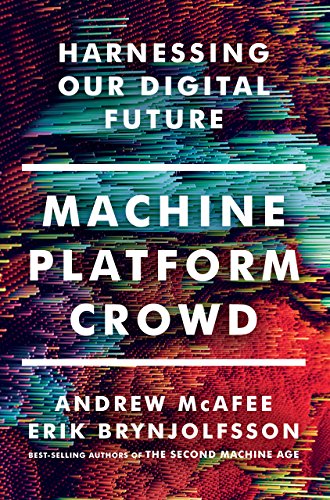Machine, Platform, Crowd: Harnessing Our Digital Future Link to heading
Summary Link to heading
“Machine, Platform, Crowd: Harnessing Our Digital Future” by Andrew McAfee and Erik Brynjolfsson explores the integration and impact of three key forces reshaping business and society: machines, platforms, and crowds. The book is structured around these three elements:
Machine: This part discusses the rise of artificial intelligence and machine learning, highlighting how machines are increasingly capable of performing tasks that once required human intelligence. The authors explore examples like self-driving cars and advanced robotics, considering the implications for labor and decision-making processes.
Platform: The book examines digital platforms that create ecosystems where buyers, sellers, and service providers interact. It delves into the transformative effects of platforms like Airbnb, Uber, and Amazon, discussing how they disrupt traditional industries by leveraging network effects.
Crowd: This section looks at the power of crowds, emphasizing the role of collective intelligence and user-generated content. The authors provide insights into how crowdsourcing and open innovation are changing the ways organizations solve problems and create value.
Review Link to heading
“Machine, Platform, Crowd” has been praised for its insightful analysis of digital trends and its ability to clearly explain complex concepts. The book provides a timely exploration of technological disruptions and their implications across multiple domains, offering a blend of theoretical insights and real-world examples. Some critiques mention that while the book is comprehensive, it occasionally lacks depth in exploring potential challenges and negative consequences of these digital transformations.
Key Takeaways Link to heading
- Embrace AI and machine learning as essential tools for decision-making and operational efficiency.
- Leverage platform-based business models to capture value from network effects and streamline interactions between stakeholders.
- Harness crowd intelligence to foster innovation and solve complex problems by tapping into diverse perspectives and expertise.
- Adapt business strategies to align with the rapid rate of technological change, emphasizing agility and openness to new opportunities.
- Recognize the potential displacement of jobs and the need for policies that address workforce transitions in the digital age.
Recommendation Link to heading
“Machine, Platform, Crowd” is particularly valuable for business leaders, policymakers, and anyone interested in understanding the forces driving digital change. The book offers a broad overview suitable for readers seeking to grasp the big picture of technological disruption and its implications for the future of work, commerce, and societal structures.
